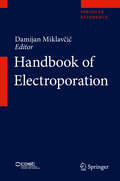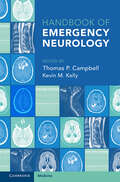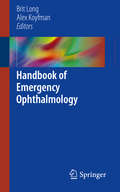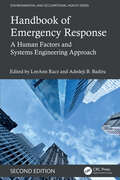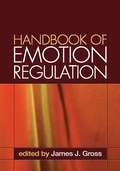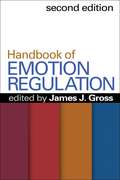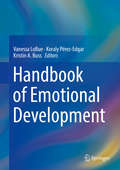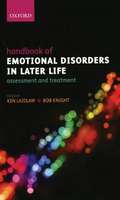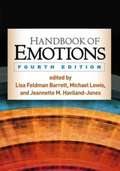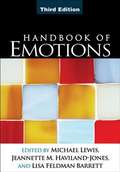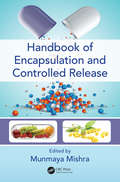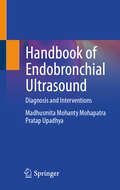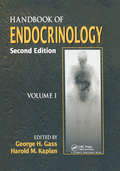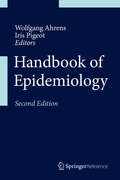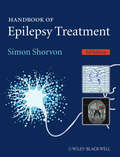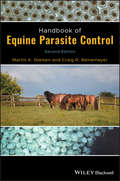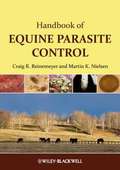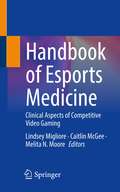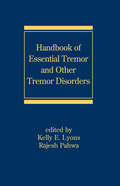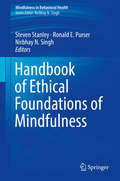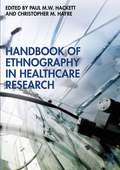- Table View
- List View
Handbook of Electroporation
by Damijan MiklavčičThis major reference work is a one-shot knowledge base on electroporation and the use of pulsed electric fields of high intensity and their use in biology, medicine, biotechnology, and food and environmental technologies. The Handbook offers a widespread and well-structured compilation of 156 chapters ranging from the foundations to applications in industry and hospital. It is edited and written by most prominent researchers in the field. With regular updates and growing in its volume it is suitable for academic readers and researchers regardless of their disciplinary expertise, and will also be accessible to students and serious general readers. The Handbook's 276 authors have established scholarly credentials and come from a wide range of disciplines. This is crucially important in a highly interdisciplinary field of electroporation and the use of pulsed electric fields of high intensity and its applications in different fields from medicine, biology, food processing, agriculture, process engineering, energy and environment. An Editorial Board of distinguished scholars from across the world has selected and reviewed the various chapters to ensure the highest quality of this Handbook.The book was edited by an international team of Section Editors: P. Thomas Vernier, Boris Rubinsky, Juergen Kolb, Damijan Miklavcic, Marie-Pierre Rols, Javier Raso, Richard Heller, Gregor Serša, Dietrich Knorr, and Eugene Vorobiev.
Handbook of Emergency Neurology: Handbook For Emergency Physicians
by Thomas P. Campbell Kevin M. KellyPatients with neurologic symptoms are frequently seen in the emergency department and require rapid and thorough evaluation. Appropriate assessment with tailored history-taking, localization of the neurological problem, differential diagnosis, focused testing, and urgent treatment when indicated are essential to prevent patient morbidity. Neurological examination and testing of patients are covered in-depth, along with common neurological presentations using a symptom-based approach, such as coma, dizziness and gait disturbance. Specific neurological disorders are also explored, including traumatic brain injury, ischemic stroke and transient ischemic attack and neurotoxicology. Chapters follow a basic outline, including an introduction and a pearls and pitfalls section, providing a succinct overview and key takeaway points for the busy clinician. This well organized handbook will serve as a concise, valued reference for the clinician to use in assisting the evaluation of the most common neurology related emergency department visits.
Handbook of Emergency Ophthalmology
by Brit Long Alex KoyfmanThis book provides emergency physicians with an easy-to-use guide for diagnosing and treating ophthalmologic conditions in the emergency department. Ophthalmologic complaints are very common, but many emergency physicians are not as confident as they would like to be when evaluating and managing these conditions. This book answers that need by giving step-by-step instructions on how to diagnose and treat common eye conditions, including glaucoma, infections, neuro-ophthalmologic conditions, and trauma. For each disorder, the book discusses presentation/symptoms, physical examination techniques, lab and imaging findings, differential diagnoses, treatment guidelines, and referral suggestions. The text is filled with images that clearly present these common ophthalmologic complaints and conditions and guide the emergency physician to an accurate and swift diagnosis. Handbook of Emergency Ophthalmology is an essential resource for emergency physicians, residents, medical students, nurses, and other healthcare workers who evaluate and manage patients with ophthalmologic conditions.
Handbook of Emergency Response: A Human Factors and Systems Engineering Approach, Second Edition (Environmental and Occupational Health Series)
by LeeAnn Racz and Adedeji B. BadiruDespite pre-emptive preparations, disasters can and do occur and are a fact of life. Whether natural disasters, catastrophic accidents, or terrorist attacks, the risk cannot be completely eliminated. A carefully prepared response is your best defense. This fully updated second edition of the Handbook of Emergency Response presents practical advice and guidelines on how to plan the coordinated execution of emergency response.This handbook incorporates human factors and a systems engineering approach to emergency response project management. It provides cutting-edge research in developing a systematic structure for communication, cooperation, and coordination. Managing a project in the wake of a tragedy is complicated and involves various emotional, sentimental, reactive, and chaotic responses. This is the time when a structured communication model is most needed. This second edition includes important lessons learned and developments since the first edition was published, as well as additional information devoted to systems thinking and industrial engineering in planning for responses to emergencies. The reader will develop a thorough understanding of how to handle an emergency response using a systems approach.The handbook is an ideal purchase for any student or practitioner of human factors, safety, systems engineering, events management, local or federal governance, or those in the emergency services.
Handbook of Emotion Regulation
by Ross A. Thompson James J. GrossThis authoritative volume provides a comprehensive road map of the important and rapidly growing field of emotion regulation. Each of the 30 chapters in this handbook reviews the current state of knowledge on the topic at hand, describes salient research methods, and identifies promising directions for future investigation. The contributors who are the foremost experts in the field address vital questions about the neurobiological and cognitive bases of emotion regulation, how we develop and use regulatory strategies across the lifespan, individual differences in emotion regulation, social psychological approaches, and implications for psychopathology, clinical interventions, and health.
Handbook of Emotion Regulation, Second Edition
by James J. GrossReviewing the state of the science in a dynamic, thriving field, this influential handbook integrates knowledge from multiple psychological subdisciplines. Foremost experts address the neurobiological and cognitive bases of emotion regulation and examine how individuals develop and use regulatory strategies across the lifespan. The social context of emotion regulation is explored, as are personality processes and individual differences. Critical implications are discussed for psychopathology, psychosocial interventions, and health. Including helpful cross-referencing among chapters, the volume describes cutting-edge methods and identifies promising directions for future investigation. New to This Edition *Incorporates significant scientific advances and many new topics. *Greatly expanded coverage of clinical issues and applications. *Chapters on neural systems, delay of gratification, decision making, and health. *Chapters on adolescence, social baseline theory, and desire regulation, plus more.
Handbook of Emotion Regulation, Second Edition
by James J. GrossReviewing the state of the science in a dynamic, thriving field, this influential handbook integrates knowledge from multiple psychological subdisciplines. Foremost experts address the neurobiological and cognitive bases of emotion regulation and examine how individuals develop and use regulatory strategies across the lifespan. The social context of emotion regulation is explored, as are personality processes and individual differences. Critical implications are discussed for psychopathology, psychosocial interventions, and health. Including helpful cross-referencing among chapters, the volume describes cutting-edge methods and identifies promising directions for future investigation. As a special bonus, purchasers of the second edition can download a supplemental e-book featuring several notable, highly cited chapters from the first edition. New to This Edition *Incorporates significant scientific advances and many new topics. *Greatly expanded coverage of clinical issues and applications. *Chapters on neural systems, delay of gratification, decision making, and health. *Chapters on adolescence, social baseline theory, and desire regulation, plus more.
Handbook of Emotional Development
by Koraly Pérez-Edgar Vanessa LoBue Kristin A. BussThis handbook offers a comprehensive review of the research on emotional development. It examines research on individual emotions, including happiness, anger, sadness, fear, and disgust, as well as self-conscious and pro-social emotions. Chapters describe theoretical and biological foundations and address the roles of cognition and context on emotional development. In addition, chapters discuss issues concerning atypical emotional development, such as anxiety, depression, developmental disorders, maltreatment, and deprivation. The handbook concludes with important directions for the future research of emotional development. Topics featured in this handbook include:The physiology and neuroscience of emotions.Perception and expression of emotional faces.Prosocial and moral emotions.The interplay of emotion and cognition.The effects of maltreatment on children’s emotional development.Potential emotional problems that result from early deprivation. The Handbook of Emotional Development is an essential resource for researchers, clinicians/professionals, and graduate students in child and school psychology, social work, public health, child and adolescent psychiatry, pediatrics, and related disciplines.
Handbook of Emotional Disorders in Later Life: Assessment and Treatment
by Bob Knight Ken LaidlawAlthough the perceptions and realities of ageing have changed markedly over the last few decades, for practitioners working with older people, emotional problems remain a major factor of health and happiness in later life. This handbook provides a concise, authoritative and up to date guide to best practice in therapy for older people, for a wide range of mental health professionals. The editors bring together chapters by experienced trainers and clinicians that cover all the significant problems and issues in the assessment and treatment of emotional disorders in later life. The introductory chapters examine the individual, social, cultural and physical experience of ageing, and provide an essential background for a caring and professional understanding of related emotional disorders and their effective treatment. Throughout the book, key research and clinical experience is reported as underlying evidence based treatment, but the emphasis is on practical guidance for assessment and interventions, rather than detailed discussion of methodological issues. With each chapter written by a specialist in their field, a range of expertise is provided in a single source, making this book an invaluable resource for anyone dealing with the mental health needs of older people.
Handbook of Emotions, Fourth Edition
by Michael Lewis Lisa Feldman Barrett Jeannette M. Haviland-JonesRecognized as the definitive reference, this handbook brings together leading experts from multiple psychological subdisciplines to examine one of today's most dynamic areas of research. Coverage encompasses the biological and neuroscientific underpinnings of emotions, as well as developmental, social and personality, cognitive, and clinical perspectives. The volume probes how people understand, experience, express, and perceive affective phenomena and explores connections to behavior and health across the lifespan. Concluding chapters present cutting-edge work on a range of specific emotions. Illustrations include 10 color plates. New to This Edition *Chapters on the mechanisms, processes, and influences that contribute to emotions (such as genetics, the brain, neuroendocrine processes, language, the senses of taste and smell). *Chapters on emotion in adolescence, older age, and in neurodegenerative dementias. *Chapters on facial expressions and emotional body language. *Chapters on stress, health, gratitude, love, and empathy. *Many new authors and topics; extensively revised with the latest theoretical and methodological innovations.
Handbook of Emotions, Third Edition
by Michael Lewis Jeannette Haviland-JonesWidely regarded as the standard reference in the field, this handbook comprehensively examines all aspects of emotion and its role in human behavior. The editors and contributors are foremost authorities who describe major theories, findings, methods, and applications. The volume addresses the interface of emotional processes with biology, child development, social behavior, personality, cognition, and physical and mental health. Also presented are state-of-the-science perspectives on fear, anger, shame, disgust, positive emotions, sadness, and other distinct emotions. Illustrations include seven color plates.
Handbook of Encapsulation and Controlled Release (Encapsulation and Controlled Release)
by Munmaya MishraThe field of encapsulation, especially microencapsulation, is a rapidly growing area of research and product development. The Handbook of Encapsulation and Controlled Release covers the entire field, presenting the fundamental processes involved and exploring how to use those processes for different applications in industry. Written at a level comp
Handbook of Endobronchial Ultrasound: Diagnosis and Interventions
by Madhusmita Mohanty Mohapatra Pratap UpadhyaThis easy-to-use pocket book covers all aspects of endobronchial ultrasound-guided transbronchial needle aspiration (EBUS-TBNA), a preferred diagnostic procedure for many pulmonary and mediastinal conditions. Chapters include topics ranging from anatomy and lymph node stations to detailed insights on endobronchial ultrasound instrumentation. The book discusses the indications and contraindications of EBUS, patient preparation, the technical aspect of scope insertion into airways, manipulation and sampling, and complications. Additionally, it provides the latest EBUS-related guidelines and serves as a handy clinical reference for practitioners. The book is relevant for postgraduate students of general and pulmonary medicine, thoracic surgeons, radiologists, nurses, EBUS technicians, and practitioners alike performing EBUS-TBNA.
Handbook of Endocrinology, Second Edition, Volume I
by George H. Gass Harold M. KaplanStay on top of the rapid changes sweeping endocrinology today with the latest information on important selected topics in The Handbook of Endocrinology. This extensive two-volume text provides an impressive breadth and depth of coverage difficult to find in other sources. After a broad survey of the functions of major endocrine glands, the book launches into detailed reviews of both established and hot, new research areas. Selected topics include:
Handbook of Endovascular Interventions
by Amit Kumar Kenneth OurielHandbook of Endovascular Interventions presents a step-wise approach to the techniques of peripheral vascular interventions. Covering interventions in all major organ systems, this concise and comprehensive resource provides the rationale on why these approaches have been adopted by most practicing vascular interventionalists. This volume also presents key information on intervention techniques and pitfalls, complications and their management, surgical management options, as well as landmark papers on the topic. Unique to this book is the inclusion of sections building an endovascular suite, and coding as well as international training paradigms across the globe. Authored by international experts from around the globe, Handbook of Endovascular Interventions is a true how-to book for the busy interventionalist.
Handbook of Endovascular Peripheral Interventions
by Yerem Yeghiazarians Christopher D OwensThe Handbook of Endovascular Peripheral Interventions has been written to serve as a comprehensive guide for both the beginner and advanced interventionalist. Covering all aspects of percutaneous peripheral vascular interventions, each chapter of this highly illustrated book provides a brief background, etiology, clinical presentation, imaging, and percutaneous treatment of different vascular conditions. Importantly, Tips of the Trade and How I Do It sections within each chapter make the handbook practical for daily use. These invaluable pearls are provided by contributing chapter authors who are experts in the field. Edited by Dr. Christopher D. Owens (Division of Vascular Surgery) and Dr. Yerem Yeghiazarians (Division of Interventional Cardiology), from the University of California San Francisco School of Medicine, the Handbook of Endovascular Peripheral Interventions is a collaborative effort between cardiologists, vascular surgeons, and radiologists. Since each subspecialty brings unique expertise and experience to the field, this handbook will be a valuable resource for all physicians currently working in peripheral vascular interventions.
Handbook of Epidemiology
by Iris Pigeot Wolfgang AhrensThis 5-volume reference covers the entire field of epidemiology, from statistical methods and study design, to specialized areas such as molecular epidemiology, and applications in clinical medicine and health services research. This updated edition of the Handbook of Epidemiology adds20 new chapters on: History of Epidemiological Methods and Concepts, Cluster Randomized Trials, Internet-Based Epidemiology, Misclassification, Sensitivity Analysis and Bias Analysis, Emergency and Disaster Health Surveillance, Statistical Inference, Data Management in Epidemiology, Bayesian Methods in Epidemiology, Generalized Estimating Equations, Directed Acyclic Graphs, Life Course Epidemiology, Physical Activity Epidemiology, Radiation Epidemiology, Epidemiology of Obesity, Epidemiology of Respiratory Allergies and Asthma, Epidemiology of Dental Diseases, Epidemiology of Digestive Diseases, Epidemiology of Psychiatric Disorders, Epidemiology of Diabetes. All other chapters are extensively revised from the 1st edition. This is a reference for epidemiological researchers and graduate students in public health. "
Handbook of Epilepsy Treatment
by Simon ShorvonMake your way through the epilepsy maze Epilepsy is a complex neurological condition. There are many modern treatment options, and treatment should nowadays be tailored to an individual patient. But identification of the best therapy can be a labyrinthine process. The Handbook of Epilepsy Treatment provides a practical pathfinder for treating epilepsy based on published evidence and the author’s 30 years of specialist clinical experience. Direct in style but comprehensive in content, with ample tables and summaries, the Handbook of Epilepsy Treatment covers: Treatment of the different forms and causes of epilepsy Treatment in the different commonly encountered clinical situations Treatment in children, in adults, in the elderly, in women, in epilepsy syndromes and in those with special needs and requirements Epilepsy drugs – their pharmacology, kinetics, side effects, effectiveness and practical usage in the clinic Epilepsy surgery – the various types, the indications, assessment and outcome A succinct pharmacopeia summarizes the entire range of anti-epileptic medications with emphasis on effective prescribing in the clinical setting. The Handbook of Epilepsy Treatment will help you and your patient find the best path to control epilepsy for each individual’s situation.
Handbook of Equine Parasite Control
by Martin K. Nielsen Craig R. ReinemeyerHandbook of Equine Parasite Control, Second Edition offers a thorough revision to this practical manual of parasitology in the horse. Incorporating new information and diagnostic knowledge throughout, it adds five new sections, new information on computer simulation methods, and new maps to show the spread of anthelmintic resistance. The book also features 30 new high-quality figures and expanded information on parasite occurrence and epidemiology, new diagnostics, treatment strategies, clinical significance of infections, anthelmintic resistance, and environmental persistence. This second edition of Handbook of Equine Parasite Control brings together all the details needed to appropriately manage parasites in equine patients and support discussions between horse owners and their veterinarians. It offers comprehensive coverage of internal parasites and factors affecting their transmission; principles of equine parasite control; and diagnosis and assessment of parasitologic information. Additionally, the book provides numerous new case histories, covering egg count results from yearlings, peritonitis and parasites, confinement and deworming, quarantine advice, abdominal distress in a foal, and more. A clear and concise user-friendly guide to equine parasite control for veterinary practitioners and students Fully updated with new knowledge and diagnostic methods throughout Features brand new case studies Presents 30 new high-quality figures, including new life-cycle charts Provides maps to show the spread of anthelmintic resistance Handbook of Equine Parasite Control is an essential guide for equine practitioners, veterinary students, and veterinary technicians dealing with parasites in the horse.
Handbook of Equine Parasite Control
by Craig Reinemeyer Martin NielsenA must-have guide for any equine veterinarian, this is a practical and concise handbook on the control of equine parasites. It enables you to advise your clients effectively on evidence-based parasite control programs. The first section of the book reviews the basic biology of internal parasites and the factors influencing their transmission. The second section discusses the general principles of parasite control. The third section provides diagnostic and assessment tools for interpreting clinical, historical and laboratory information. Finally the fourth section contains 20 case studies reflecting the full range of parasites and providing detailed answers and discussions, providing you with the opportunity to practice the application of knowledge and illustrating the concepts of modern parasite control.Handbook of Equine Parasite Control is an invaluable companion for equine veterinary practitioners, veterinary students, equine veterinary technicians and nurses, researchers in equine parasitology, horse owners, and farm and stable managers.
Handbook of Esports Medicine: Clinical Aspects of Competitive Video Gaming
by Lindsey Migliore Caitlin McGee Melita N. MooreWith over 450 million viewers worldwide and over $1 billion in revenue in 2019, competitive video gaming - known more popularly as esports - is not a fad, but rather a technological and cultural phenomenon. To remain competitive in this popular and sometimes lucrative field, gamers often practice upwards of 12 hours a day, performing anywhere from 400-600 actions per minute. As such, they are susceptible to a unique set of injuries and disorders from these complex movements, extended screen time and sedentary tendencies. This population requires motivated and educated healthcare providers familiar with their lifestyle and ailments to effectively prevent, diagnose, and treat relevant esports medical conditions. This handbook will serve as the first of its kind, an in-depth dive into the fundamentals of treating competitive video gamers created by the medical professionals and industry leaders.Esports medicine is a subspecialty in its infancy: Research, resources, and guidelines are evolving rapidly as more is understood about this burgeoning patient population. This unique handbook will provide a comprehensive overview of the basics of esports, play mechanics and terminology specifically targeted towards healthcare professionals previously unfamiliar with the subject matter. It will convey the essentials of an esports history and physical exam and act as a step-by-step guide for treating video gamers and esports athletes. Furthermore, it will guide providers through each and every major diagnosis related to gaming, with the specific mechanisms of the injury, relevant physical exam maneuvers, and treatments selected specifically for gaming, covering upper and lower extremity injuries, conditions of the neck and back, gaming ergonomics, and psychological, nutritional and cultural considerations. Timely and practical, Handbook of Esports Medicine will be a valuable resource for primarily sports medicine, orthopedic, physical medical and rehabilitation, and pediatric physicians, as well as therapists, psychologists and trainers involved in competitive gaming.
Handbook of Essential Tremor and Other Tremor Disorders (Neurological Disease and Therapy)
by Rajesh Pahwa Kelly E. LyonsFilling a gap in the literature, this reference offers 25 authoritative chapters on the epidemiology, clinical characteristics, and medical and surgical treatment of essential tremor and various tremor disorders, including chapters on Parkinsonian, cerebellar, neuropathic, post-traumatic, psychogenic, and drug-induced tremor. Reporting on the lates
Handbook of Ethical Foundations of Mindfulness (Mindfulness in Behavioral Health)
by Nirbhay N. Singh Ronald E. Purser Steven StanleyThis handbook explores the multifaceted ethical dimensions of mindfulness, from early Buddhist sources to present-day Western interpretations of mindfulness. It takes a modern ethical approach to the study of mindfulness, and traces contemporary mindfulness practice from solitary journey to the global whole. Noted practitioners, teachers, scholars, and other professionals lend diverse perspectives to the debate over the moral content of mindfulness and its status as religious, secular, or post-secular practice. Chapters offer new views on the roots of mindfulness in Buddhist moral teachings, ethical mindfulness in interpersonal relationships, and the necessity of ethics in mindfulness-based education and therapy. Chapters also discuss current debates concerning the ethics of mindfulness across the applied fields of education and pedagogy, business, economics, and the environment. Topics featured in this handbook include: · Mindfulness as the true foundation of a naturally ethical life. · Mindfulness and its impact on emotional life, interpersonal relationships, and forgiveness. · How Buddhist ethics informs spiritual practice across the three main vehicles (yanas) of Buddhism and its relation to mindfulness. · “McMindfulness”, or the mass marketization and commodification of mindfulness-based interventions (MBIs). · How an ethic of interdependence formed by Buddhist principles and mindfulness practices can help address the environmental crisis. The Handbook of Ethical Foundations of Mindfulness is a must-have resource for researchers, clinicians/professionals, and graduate students in psychology, complementary and alternative medicine, and social work as well as occupational and rehabilitation therapy, nursing, philosophy, business management, and teachers of Buddhism and meditation.
Handbook of Ethnography in Healthcare Research
by Hackett, Paul M.W.This handbook provides an up-to-date reference point for ethnography in healthcare research. Taking a multi-disciplinary approach, the chapters offer a holistic view of ethnography within medical contexts. This edited volume is organized around major methodological themes, such as ethics, interviews, narrative analysis and mixed methods. Through the use of case studies, it illustrates how methodological considerations for ethnographic healthcare research are distinct from those in other fields. It has detailed content on the methodological facets of undertaking ethnography for prospective researchers to help them to conduct research in both an ethical and safe manner. It also highlights important issues such as the role of the researcher as the key research instrument, exploring how one’s social behaviours enable the researcher to ‘get closer’ to his/her participants and thus uncover original phenomena. Furthermore, it invites critical discussion of applied methodological strategies within the global academic community by pushing forward the use of ethnography to enhance the body of knowledge in the field. The book offers an original guide for advanced students, prospective ethnographers, and healthcare professionals aiming to utilize this methodological approach.
Handbook of European Homicide Research
by William Alex Pridemore Marieke C. LiemThis comprehensive work provides a sourcebook of information about the substantive, methodological, and policy-oriented aspects of homicide research in Europe. Part one of this work covers the most recent substantive and methodological information about European homicide research. The second part will contains detailed case studies on homicide research in 15-20 individual European nations. This work will be both conceptual and practical. conceptual and practical. Conceptual aspects will focus on theoretical frameworks and patterns and trends of violence in Europe. Practical aspects will examine the results of empirical research, topics relating to different data sources and the variation of legal definitions of violence throughout Europe, and policy issues relating to variation in homicide prevention and punishment of homicide offenders throughout Europe. This handbook will not only provide an up-to-date reference that brings together known information, but will also offer previously unpublished comprehensive literature reviews and original research findings. The editors' distinctive approach is to provide readers with an English-language central source of information about the voluminous literature on European homicide research that is currently spread widely in dozens of different European and American journals.
